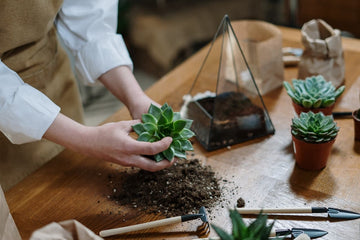The Ultimate Terrarium Kit Buying Guide: Everything You Need to Know
Welcome to the ultimate terrarium kit buying guide, your one-stop resource for everything you need to know about creating your own miniature indoor gardens. Whether you're a seasoned plant enthusiast looking for new additions to your collection, or a beginner looking to add some greenery to your home, this guide has got you covered.
In this comprehensive buying guide, we will take you through the essential factors to consider when choosing a terrarium kit. From the types of terrariums available, to the necessary supplies and accessories, we'll help you make an informed decision that suits your style and level of expertise.
Our goal is to empower you with the knowledge to create and maintain a stunning terrarium that thrives in any environment. We'll share expert tips and insights, so you can troubleshoot common issues and unlock the secrets to a thriving miniature ecosystem.
Ready to embark on your terrarium journey? Let's dig in and explore the world of terrarium kits together.
Benefits of having a terrarium
Terrariums offer a range of benefits, making them a popular choice for plant lovers. Firstly, they are an excellent way to bring nature indoors, especially if you have limited space or live in an urban environment. Terrariums provide a miniaturized version of the natural world, allowing you to enjoy the beauty of plants up close.
Additionally, terrariums create a self-contained ecosystem that requires minimal maintenance. They are designed to be self-sustaining, meaning they require less watering than traditional potted plants. This makes them ideal for busy individuals or those who may not have a green thumb.
Terrariums also offer health benefits. Plants naturally purify the air by removing toxins and releasing oxygen. Having a terrarium in your home can improve air quality and create a healthier living environment. Studies have shown that being around plants can also reduce stress levels and improve overall well-being.
Types of terrariums - closed vs. open

When it comes to choosing a terrarium, you'll need to decide between a closed or open design. Closed terrariums have a sealed lid, creating a mini greenhouse effect. This type of terrarium is ideal for plants that thrive in high humidity environments, such as ferns and mosses. The sealed environment helps to retain moisture, reducing the need for frequent watering.
On the other hand, open terrariums have an open top and allow for better airflow. This type of terrarium is suitable for plants that prefer drier conditions, such as succulents and cacti. The open design allows for better ventilation, preventing the buildup of excess moisture.
Consider the type of plants you want to grow and the environment you can provide when choosing between a closed or open terrarium. If you're unsure, you can opt for a terrarium kit that offers both options, giving you the flexibility to experiment with different plants.
Choosing the right terrarium kit for your needs
Now that you have an understanding of the different types of terrariums, it's time to choose the right terrarium kit for your needs. When selecting a kit, there are a few key factors to consider.
Firstly, consider the size of the terrarium. This will depend on the available space in your home and the number of plants you want to include. Smaller terrariums are great for desktops or small shelves, while larger terrariums can become a statement piece in your living room.
Next, consider the materials used in the kit. The most common materials include glass or acrylic containers. Glass terrariums offer a classic and elegant look, while acrylic terrariums are more lightweight and durable. Consider your personal preference and the style of your home when choosing the material.
Another important factor is the quality of the components included in the kit. Look for kits that provide high-quality soil, gravel, activated charcoal, and other essential supplies. These components are crucial for creating a healthy environment for your plants to thrive.
Lastly, consider the level of experience required. Some kits are designed for beginners and come with detailed instructions, while others are more suitable for experienced gardeners. Choose a kit that matches your level of expertise, or be prepared to do some additional research if you're new to terrarium gardening.
Essential components of a terrarium kit
A terrarium kit typically includes several essential components that are necessary for creating a successful terrarium. Here are the key components you should expect to find in a quality terrarium kit:
1. Container: The container is the foundation of your terrarium. It should be made of glass or acrylic and have a suitable size and shape for your chosen plants.
2. Soil: High-quality potting soil is essential for providing nutrients to your plants. Look for a well-draining soil mix that is suitable for the types of plants you intend to grow.
3. Gravel: A layer of gravel at the bottom of the terrarium helps with drainage and prevents water from pooling around the roots of your plants.
4. Activated Charcoal: Activated charcoal serves as a natural filter, absorbing odors and impurities in the terrarium. It helps to keep the environment clean and fresh.
5. Moss: Moss acts as a natural carpet, providing a lush and green base for your terrarium. It also helps retain moisture and adds aesthetic appeal.
6. Decorative Elements: Depending on your personal style, you may want to include decorative elements such as rocks, pebbles, or figurines to enhance the visual appeal of your terrarium.
7. Tools: Some terrarium kits may include tools such as a small shovel, tweezers, or a spray bottle for watering.
When purchasing a terrarium kit, ensure that it includes all these essential components. If any components are missing, you may need to purchase them separately.
DIY terrarium kits for a personalized touch
If you're feeling creative, you may want to consider creating your own DIY terrarium kit. This allows you to handpick the components and personalize your terrarium to your liking. Here's what you'll need to create your own DIY terrarium kit:
1. Container: Choose a glass or acrylic container that suits your style and desired size.
2. Soil: Select a well-draining potting soil mix that is suitable for the types of plants you want to grow.
3. Gravel: Look for small pebbles or gravel that will provide adequate drainage for your terrarium.
4. Activated Charcoal: Purchase activated charcoal to keep the terrarium environment clean and odor-free.
5. Moss: Collect or purchase moss to create a lush green base for your terrarium.
6. Decorative Elements: Choose decorative elements such as rocks, pebbles, or figurines to add a personal touch to your terrarium.
7. Plants: Select plants that are suitable for the type of terrarium you want to create. Consider their light and humidity requirements.
By creating your own DIY terrarium kit, you have complete control over the components and can customize your terrarium to suit your preferences. It's a fun and rewarding way to showcase your creativity.
Maintenance and care tips for terrariums
Once you have set up your terrarium, it's important to know how to properly maintain and care for it. Here are some essential tips to keep your terrarium thriving:
1. Watering: Different plants have different water requirements, so it's important to understand the needs of your specific plants. Generally, terrariums require less watering compared to traditional potted plants. Monitor the soil moisture and water only when necessary.
2. Light: Most terrarium plants prefer indirect sunlight. Place your terrarium in a location that receives bright, indirect light. Avoid placing it in direct sunlight, as this can cause the terrarium to overheat.
3. Ventilation: For open terrariums, ensure there is adequate airflow to prevent the buildup of excess moisture. You can slightly open the lid or remove it for a short period each day to allow for ventilation.
4. Pruning: Regularly prune your plants to maintain their shape and prevent overcrowding. Remove any dead or decaying leaves to keep the terrarium clean and healthy.
5. Cleaning: Occasionally, you may need to clean the inside of your terrarium. Wipe the glass or acrylic surfaces with a soft cloth to remove any dust or dirt. Be careful not to disturb the plants or decorative elements.
Following these maintenance and care tips will help your terrarium thrive and remain a beautiful addition to your home.
Frequently asked questions about terrarium kits
1. Can I use any container for a terrarium?
While you can use various containers for a terrarium, it's important to choose one made of glass or acrylic to create a suitable environment for the plants.
2. How often should I water my terrarium?
The watering frequency depends on the types of plants you have and the moisture levels in the terrarium. Monitor the soil moisture and water only when necessary.
3. Can I use artificial plants in a terrarium?
While artificial plants can be used in a terrarium for decoration, they won't contribute to the overall health of the ecosystem. Live plants are recommended for a thriving terrarium.
4. Do terrariums require direct sunlight?
Most terrarium plants prefer bright, indirect light. Avoid placing your terrarium in direct sunlight, as this can cause overheating and damage to the plants.
5. Can I add live insects to my terrarium?
It's generally not recommended to introduce live insects into your terrarium, as they can disrupt the ecosystem and potentially harm the plants.
Final thoughts
Creating a terrarium is a rewarding and enjoyable experience that allows you to bring the beauty of nature indoors. By choosing the right terrarium kit and following proper maintenance and care tips, you can create a stunning miniature garden that thrives in any environment.
Remember to consider the type of terrarium, the quality of the components, and your level of expertise when selecting a terrarium kit. If you prefer a more personalized touch, you can create your own DIY terrarium kit and handpick the components.
With this comprehensive buying guide, you now have the knowledge to embark on your terrarium journey with confidence. Explore the world of terrariums, unleash your creativity, and enjoy the benefits of having a living piece of nature in your home. Happy terrarium gardening!
---
I hope you find this blog article helpful and engaging. If you have any further questions or need assistance with anything else, feel free to ask.

